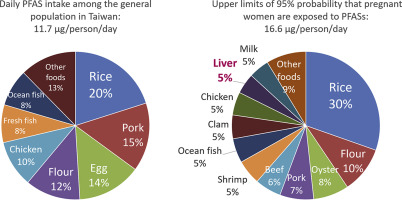当前位置:
X-MOL 学术
›
J. Food Drug Anal.
›
论文详情
Our official English website, www.x-mol.net, welcomes your
feedback! (Note: you will need to create a separate account there.)
Concentrations of perfluoroalkyl substances in foods and the dietary exposure among Taiwan general population and pregnant women
Journal of Food and Drug Analysis ( IF 2.6 ) Pub Date : 2018-07-01 , DOI: 10.1016/j.jfda.2017.12.011 Wen-Ling Chen, Fang-Yu Bai, Ying-Chia Chang, Pau-Chung Chen, Chia-Yang Chen
Journal of Food and Drug Analysis ( IF 2.6 ) Pub Date : 2018-07-01 , DOI: 10.1016/j.jfda.2017.12.011 Wen-Ling Chen, Fang-Yu Bai, Ying-Chia Chang, Pau-Chung Chen, Chia-Yang Chen

|
This study quantified five perfluorocarboxylic acids (PFCAs) and two perfluorosulfonic acids in cereals, meats, seafood, eggs, pork liver, and milk in Taiwan using ultra-performance liquid chromatography-tandem mass spectrometry and evaluated the dietary exposure of the general population and pregnant women using per capita consumption and a questionnaire, respectively. Perfluorooctanoic acid (PFOA) and PFCAs of 10-12 carbons were found in almost all of the samples in considerable concentrations in rice and pork liver, reaching as high as 283 ng/g (PFOA in pork liver); the levels are two to three orders of magnitude higher than previous reports. Perfluorooctane sulfonate (PFOS), the most frequently mentioned perfluoroalkyl substance, was rarely detected in many food items (detection frequencies <20% in rice, flour, pork, chicken, salmon, squid, eggs, and milk) at <0.4 ng/g, except for beef, pork liver and some seafood (detection frequencies: 100%, GMs: 0.05-3.52 ng/g). Compared to populations in Western countries, people in Taiwan are exposed to much more perfluorohexanoic acid, PFOA, perfluorodecanoic acid, and perfluoroundecanoic acid (11.2, 85.1, 44.2, and 4.45 ng/kg b.w./day, respectively), mainly due to the higher contaminations in food. The exposure of 8.0 μg PFOA/person/day in the 95 percentile of pregnant women was due to their frequent consumption of pork liver.
更新日期:2018-07-01











































 京公网安备 11010802027423号
京公网安备 11010802027423号